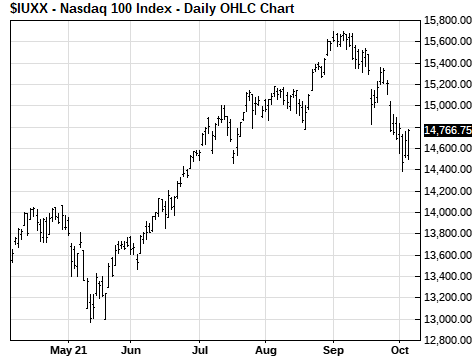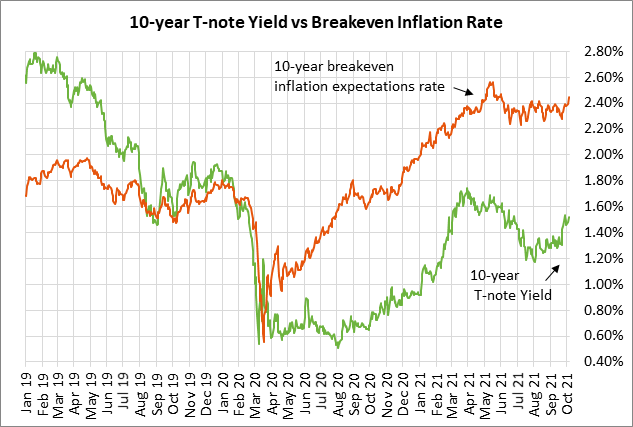- Senate reaches deal to delay debt ceiling showdown until December
- Unemployment claims expected to show a continued slow improvement in U.S. labor market
Senate reaches deal to delay debt ceiling showdown until December — The markets were relieved that Senate leaders Schumer and McConnell reached a deal for a temporary 2-month debt ceiling increase until December.
The deal alleviated market fears that Democrats might not be able to pass a debt ceiling increase with reconciliation before Treasury Secretary Yellen’s drop-dead date of October 18. However, the temporary debt ceiling increase did not solve the problem and simply kicked the can down the road until December.
Senate Minority Leader McConnell on Wednesday gave Democrats an off-ramp from the current showdown. However, Mr. McConnell still fully intends to force Democrats to increase the debt ceiling by a dollar amount through the reconciliation process. Republicans will then use that debt ceiling hike in campaign ads for the November 2022 mid-term elections. To no avail, Democrats have been trying to force Republicans into a debt ceiling suspension, which is considered politically less damaging than an increase.
If Democrats can agree amongst themselves on a $3.5 trillion spending bill, or something less than that figure, then they could add a debt ceiling hike to that bill and pass the whole package through reconciliation. Alternatively, Democrats could raise the debt ceiling as a standalone bill through reconciliation, without the excuse that there isn’t enough time.
Still, Democrats continue to insist that they won’t raise the debt ceiling through reconciliation. That leaves the possibility of another last-minute showdown on the debt ceiling in December.
The 2-month delay of the debt ceiling showdown will give Democrats time to work on trying to pass their $3.5 trillion spending bill and the $550 billion infrastructure bill. The stock market would like to see those bills pass since the fiscal stimulus would boost the economy, although the stock market is clearly not happy about the corporate tax hike in the reconciliation bill.
December will now turn out to be a very busy month for Congress. The continuing resolution (CR) expires on December 3. If Congress does not pass another CR or an omnibus spending bill by December 3, then there will be a partial government shutdown. The markets don’t get too worried about temporary government shutdowns, but it would be another negative sign of Washington dysfunction that isn’t helpful for the overall stock market climate.


Unemployment claims expected to show a continued slow improvement in U.S. labor market — Today’s unemployment claims report is expected to show a continued slow improvement in the U.S. labor market. The consensus is for today’s initial unemployment claims report to show a -14,000 decline to 348,000, more than reversing last week’s +11,000 increase to 362,000. Meanwhile, today’s continuing claims report is expected to show a decline of -40,000 to 2.762 million, adding to last week’s -18,000 decline to 2.802 million.
The initial and continuing claims series are not far from their recent lows. Initial claims are +50,000 above the 19-month low of 312,000 posted in the week ended Sep 3, while continuing claims are 87,000 above the 19-month low of 2.714 million posted in the week ended Sep 3. Relative to the pre-pandemic levels, initial claims are elevated by +146,000, and continuing claims are elevated by 1.094 million.
On the labor front, the markets are mainly looking ahead to Friday’s Sep unemployment report. The consensus is for Sep nonfarm payrolls to show an increase of +488,000. The markets are hoping for an improvement in payroll growth after August’s disappointing report of +235,000, which was far below market expectations of +620,000.
Payroll growth sizzled from May through July as the pandemic eased (May +614,000, June +962,000, July +1.053 million). However, payroll growth then fizzled in August.
Job growth this summer was negatively impacted by the resurgence of the pandemic caused by the delta variant. Businesses pulled back to see how long the pandemic resurgence would last and the extent to which the economy would be hurt. Also, vulnerable sectors were hurt, such as restaurants, travel, and entertainment.
Job gains were curbed in August as the Covid infection figures continued to climb through the month. The 7-day average of daily U.S. Covid infections rose steadily during August, beginning the month at 69,942 and ending the month at 162,273. The 7-day average didn’t peak until mid-September at 171,850.
The good news is that the 7-day average of daily U.S. Covid infections has steadily declined since the mid-September peak and fell to a 2-month low of 103,249 on Tuesday. The decline in the infection rate may have come too late to help job gains in September, but the fading pandemic seems likely to produce much better job figures in October.
There was good news on the labor front on Wednesday. The Sep ADP employment report rose by +568,000, which was substantially better than expectations of +430,000 and an improvement from the +326,000 increase seen in July and the +374,000 increase seen in August.
The consensus is for Friday’s Sep unemployment rate to fall by another -0.1 point to 5.1%, adding to August’s -0.2 point decline to a 1-1/2 year low of 5.2%. The current unemployment rate of 5.2% is still well above the record low of +3.5% seen prior to the pandemic.


